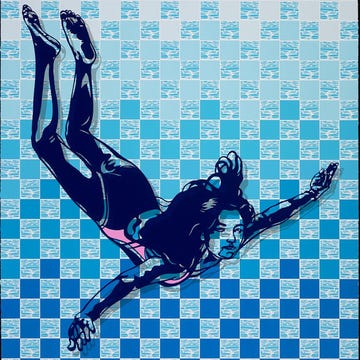The graphic novel My Time Machine (Fantagraphics) begins with the unnamed protagonist, trapped in the year 30,000,020. She wanted to see what the future held, but she never intended to jump forward 30 million years. The instrument panels inform her that the atmosphere outside her time-travel machine is unsafe, so she can’t venture out to explore. That’s just as well, because all that she can see is a barren wasteland.
Her only hope is to do the same thing we all do when our technology fails: completely shut everything off and reboot it. Of course, she’s also shutting off her life support systems, risking far more than we do in 2024.
In a series of flashbacks, we learn that the time traveler started her journey in the year 2020, a few years after convincing her ex-husband to help her build a time-travel device. As pandemic projects go, that sure beats the hell out of baking a bunch of sourdough loaves.
This essay was adapted from the Alta Weekly Newsletter, delivered every Thursday. To keep reading, become an Alta Journal member for as little as $3 a month.
SIGN UP
The graphic novel is set in a world where the time machine described in the 1895 H.G. Wells novel The Time Machine was real and could be reverse engineered from surviving diagrams.
My Time Machine was created by cartoonist and writer Carol Lay, an icon of the alt-comics scene since the Reagan era. She published pieces in landmark underground anthologies like Weirdo and Wimmen’s Comix, as well as her own series Good Girls, which offered sardonic punk riffs on romance comics. Probably best known for her long-running strip Story Minute, which appeared regularly in LA Weekly and later in Salon, she has also done commercial work for DC, Marvel, and Matt Groening’s Bongo Comics.
The protagonist of My Time Machine, who bears more than a passing resemblance to the illustrator, is a divorced cartoonist in her mid-60s who enjoys playing music on an English concertina. But this graphic novel isn’t simply an example of what sci-fi fans sometimes dismissively refer to as a Mary Sue story, in which the writer inserts an unrealistically perfect version of themself into a well-known property. Lay has created a serious work of speculative fiction. It’s clear that she’s fascinated by the practicalities and paradoxes of time travel.
She’s also crafted a meditation on the future of California, her home for most of her life. “I feel a very strong connection to the state,” she says. “My grandmother was born in San Francisco and survived the Great Fire of 1906. My mother was born down the coast in San Simeon, on a farm next to the Hearst ranch. I was born even farther south in Whittier, land of Nixon.”
The precarious state of this state is the animating force in My Time Machine. “I’ve seen flames burning behind Griffith Observatory and choked on the horrific air during the Paradise fire, which polluted the Central Valley when I was living in Sacramento,” says Lay. “When something bothers me, I write about it.”
Before getting stuck in the year 30,000,020, Lay’s fictional alter ego explores the near future of her California environs in the 2030s and 2040s, and what she finds there is dire but not entirely unfamiliar: eco-catastrophe, government oppression, surveillance, AI and drone technologies spinning out of control, and societal breakdown.
It’s a bleak vision, but My Time Machine isn’t all doom and gloom. “The ending of the book surprised me when I wrote it,” she says. “I hadn’t expected the ray of hope nor the empowerment that comes from taking action.”•
Chris Baker lives in Oakland, where he writes about pop culture and history for outlets like Wired, Rolling Stone, Slate, and his Substack.












